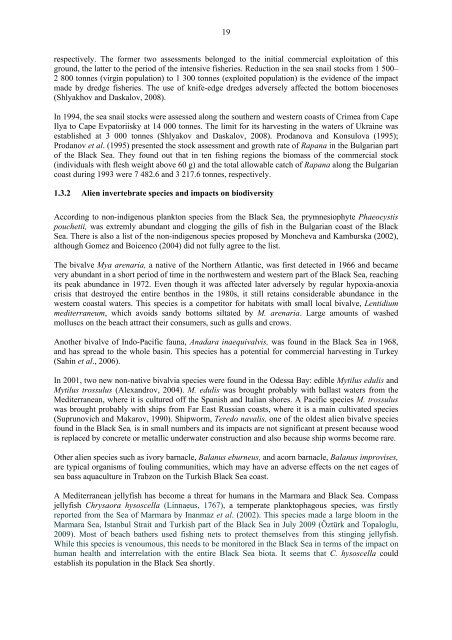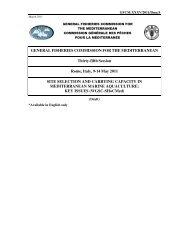Status of alien species in the Mediterranean and Black Sea
Status of alien species in the Mediterranean and Black Sea
Status of alien species in the Mediterranean and Black Sea
Create successful ePaper yourself
Turn your PDF publications into a flip-book with our unique Google optimized e-Paper software.
19<br />
respectively. The former two assessments belonged to <strong>the</strong> <strong>in</strong>itial commercial exploitation <strong>of</strong> this<br />
ground, <strong>the</strong> latter to <strong>the</strong> period <strong>of</strong> <strong>the</strong> <strong>in</strong>tensive fisheries. Reduction <strong>in</strong> <strong>the</strong> sea snail stocks from 1 500–<br />
2 800 tonnes (virg<strong>in</strong> population) to 1 300 tonnes (exploited population) is <strong>the</strong> evidence <strong>of</strong> <strong>the</strong> impact<br />
made by dredge fisheries. The use <strong>of</strong> knife-edge dredges adversely affected <strong>the</strong> bottom biocenoses<br />
(Shlyakhov <strong>and</strong> Daskalov, 2008).<br />
In 1994, <strong>the</strong> sea snail stocks were assessed along <strong>the</strong> sou<strong>the</strong>rn <strong>and</strong> western coasts <strong>of</strong> Crimea from Cape<br />
Ilya to Cape Evpatoriisky at 14 000 tonnes. The limit for its harvest<strong>in</strong>g <strong>in</strong> <strong>the</strong> waters <strong>of</strong> Ukra<strong>in</strong>e was<br />
established at 3 000 tonnes (Shlyakov <strong>and</strong> Daskalov, 2008). Prodanova <strong>and</strong> Konsulova (1995);<br />
Prodanov et al. (1995) presented <strong>the</strong> stock assessment <strong>and</strong> growth rate <strong>of</strong> Rapana <strong>in</strong> <strong>the</strong> Bulgarian part<br />
<strong>of</strong> <strong>the</strong> <strong>Black</strong> <strong>Sea</strong>. They found out that <strong>in</strong> ten fish<strong>in</strong>g regions <strong>the</strong> biomass <strong>of</strong> <strong>the</strong> commercial stock<br />
(<strong>in</strong>dividuals with flesh weight above 60 g) <strong>and</strong> <strong>the</strong> total allowable catch <strong>of</strong> Rapana along <strong>the</strong> Bulgarian<br />
coast dur<strong>in</strong>g 1993 were 7 482.6 <strong>and</strong> 3 217.6 tonnes, respectively.<br />
1.3.2 Alien <strong>in</strong>vertebrate <strong>species</strong> <strong>and</strong> impacts on biodiversity<br />
Accord<strong>in</strong>g to non-<strong>in</strong>digenous plankton <strong>species</strong> from <strong>the</strong> <strong>Black</strong> <strong>Sea</strong>, <strong>the</strong> prymnesiophyte Phaeocystis<br />
pouchetii, was extremly abundant <strong>and</strong> clogg<strong>in</strong>g <strong>the</strong> gills <strong>of</strong> fish <strong>in</strong> <strong>the</strong> Bulgarian coast <strong>of</strong> <strong>the</strong> <strong>Black</strong><br />
<strong>Sea</strong>. There is also a list <strong>of</strong> <strong>the</strong> non-<strong>in</strong>digenous <strong>species</strong> proposed by Moncheva <strong>and</strong> Kamburska (2002),<br />
although Gomez <strong>and</strong> Boicenco (2004) did not fully agree to <strong>the</strong> list.<br />
The bivalve Mya arenaria, a native <strong>of</strong> <strong>the</strong> Nor<strong>the</strong>rn Atlantic, was first detected <strong>in</strong> 1966 <strong>and</strong> became<br />
very abundant <strong>in</strong> a short period <strong>of</strong> time <strong>in</strong> <strong>the</strong> northwestern <strong>and</strong> western part <strong>of</strong> <strong>the</strong> <strong>Black</strong> <strong>Sea</strong>, reach<strong>in</strong>g<br />
its peak abundance <strong>in</strong> 1972. Even though it was affected later adversely by regular hypoxia-anoxia<br />
crisis that destroyed <strong>the</strong> entire benthos <strong>in</strong> <strong>the</strong> 1980s, it still reta<strong>in</strong>s considerable abundance <strong>in</strong> <strong>the</strong><br />
western coastal waters. This <strong>species</strong> is a competitor for habitats with small local bivalve, Lentidium<br />
mediterraneum, which avoids s<strong>and</strong>y bottoms siltated by M. arenaria. Large amounts <strong>of</strong> washed<br />
molluscs on <strong>the</strong> beach attract <strong>the</strong>ir consumers, such as gulls <strong>and</strong> crows.<br />
Ano<strong>the</strong>r bivalve <strong>of</strong> Indo-Pacific fauna, Anadara <strong>in</strong>aequivalvis, was found <strong>in</strong> <strong>the</strong> <strong>Black</strong> <strong>Sea</strong> <strong>in</strong> 1968,<br />
<strong>and</strong> has spread to <strong>the</strong> whole bas<strong>in</strong>. This <strong>species</strong> has a potential for commercial harvest<strong>in</strong>g <strong>in</strong> Turkey<br />
(Sah<strong>in</strong> et al., 2006).<br />
In 2001, two new non-native bivalvia <strong>species</strong> were found <strong>in</strong> <strong>the</strong> Odessa Bay: edible Mytilus edulis <strong>and</strong><br />
Mytilus trossulus (Alex<strong>and</strong>rov, 2004). M. edulis was brought probably with ballast waters from <strong>the</strong><br />
<strong>Mediterranean</strong>, where it is cultured <strong>of</strong>f <strong>the</strong> Spanish <strong>and</strong> Italian shores. A Pacific <strong>species</strong> M. trossulus<br />
was brought probably with ships from Far East Russian coasts, where it is a ma<strong>in</strong> cultivated <strong>species</strong><br />
(Suprunovich <strong>and</strong> Makarov, 1990). Shipworm, Teredo navalis, one <strong>of</strong> <strong>the</strong> oldest <strong>alien</strong> bivalve <strong>species</strong><br />
found <strong>in</strong> <strong>the</strong> <strong>Black</strong> <strong>Sea</strong>, is <strong>in</strong> small numbers <strong>and</strong> its impacts are not significant at present because wood<br />
is replaced by concrete or metallic underwater construction <strong>and</strong> also because ship worms become rare.<br />
O<strong>the</strong>r <strong>alien</strong> <strong>species</strong> such as ivory barnacle, Balanus eburneus, <strong>and</strong> acorn barnacle, Balanus improvises,<br />
are typical organisms <strong>of</strong> foul<strong>in</strong>g communities, which may have an adverse effects on <strong>the</strong> net cages <strong>of</strong><br />
sea bass aquaculture <strong>in</strong> Trabzon on <strong>the</strong> Turkish <strong>Black</strong> <strong>Sea</strong> coast.<br />
A <strong>Mediterranean</strong> jellyfish has become a threat for humans <strong>in</strong> <strong>the</strong> Marmara <strong>and</strong> <strong>Black</strong> <strong>Sea</strong>. Compass<br />
jellyfish Chrysaora hysoscella (L<strong>in</strong>naeus, 1767), a temperate planktophagous <strong>species</strong>, was firstly<br />
reported from <strong>the</strong> <strong>Sea</strong> <strong>of</strong> Marmara by Inanmaz et al. (2002). This <strong>species</strong> made a large bloom <strong>in</strong> <strong>the</strong><br />
Marmara <strong>Sea</strong>, Istanbul Strait <strong>and</strong> Turkish part <strong>of</strong> <strong>the</strong> <strong>Black</strong> <strong>Sea</strong> <strong>in</strong> July 2009 (Öztürk <strong>and</strong> Topaloglu,<br />
2009). Most <strong>of</strong> beach ba<strong>the</strong>rs used fish<strong>in</strong>g nets to protect <strong>the</strong>mselves from this st<strong>in</strong>g<strong>in</strong>g jellyfish.<br />
While this <strong>species</strong> is venoumous, this needs to be monitored <strong>in</strong> <strong>the</strong> <strong>Black</strong> <strong>Sea</strong> <strong>in</strong> terms <strong>of</strong> <strong>the</strong> impact on<br />
human health <strong>and</strong> <strong>in</strong>terrelation with <strong>the</strong> entire <strong>Black</strong> <strong>Sea</strong> biota. It seems that C. hysoscella could<br />
establish its population <strong>in</strong> <strong>the</strong> <strong>Black</strong> <strong>Sea</strong> shortly.
















